2018 NISSAN ALTIMA oil capacities
[x] Cancel search: oil capacitiesPage 332 of 467

∙ Your vehicle will reach its ideal oper-ating temperature more quickly
while driving versus idling.
10. Keeping your Vehicle Cool
∙ Park your vehicle in a covered parking area or in the shade whenever pos-
sible.
∙ When entering a hot vehicle, opening the windows will help to reduce the
inside temperature faster, resulting in
reduced demand on your A/C sys-
tem. ∙ Keep your engine tuned up.
∙ Follow the recommended scheduled
maintenance.
∙ Keep the tires inflated to the correct pressure. Low tire pressure increases
tire wear and lowers fuel economy.
∙ Keep the wheels in correct alignment. Improper alignment increases tire wear
and lowers fuel economy.
∙ Use the recommended viscosity engine oil. For additional information, refer to
“Recommended fluids/lubricants and
capacities” in the “Technical and con-
sumer information” section of this
manual.
INCREASING FUEL ECONOMY
5-78Starting and driving
Page 422 of 467

Engine coolant*:Replace coolant at the
specified interval. When adding or replac-
ing coolant, be sure to use only Genuine
NISSAN Long Life Antifreeze/Coolant (blue)
or equivalent with the proper mixture. (For
additional information on the proper mix-
ture for your area, refer to “Engine cooling
system” in the “Do-it-yourself ” section of
this manual.)
NOTE: Mixing any other type of coolant
or the use of non-distilled water may re-
duce the recommended service interval
of the coolant.
Engine oil and oil filter: Replace engine oil
and oil filter at the specified intervals. For
recommended oil grade and viscosity refer
to “Recommended fluids/lubricants and
capacities” in the “Technical and consumer
information” section of this manual.
Engine valve clearance*: Inspect only if
valve noise increases. Adjust valve clear-
ance if necessary.
Evaporative emissions control vapor
lines*: Check vapor lines for leaks or loose-
ness. Tighten connections or replace parts
as necessary.
Fuel filter: Periodic maintenance is not re-
quired. (in-tank type filter) Fuel lines*:
Check the fuel hoses, piping
and connections for leaks, looseness, or
deterioration. Tighten connections or re-
place parts as necessary.
Spark plugs: Replace at specified intervals.
Install new plugs of the type as originally
equipped.
CHASSIS AND BODY
MAINTENANCE:
Brake lines and cables: Visually inspect for
proper installation. Check for chafing,
cracks, deterioration, and signs of leaking.
Replace any deteriorated or damaged
parts immediately.
Brake pads and rotors: Check for wear,
deterioration and fluid leaks. Replace any
deteriorated or damaged parts immedi-
ately.
Exhaust system: Visually inspect the ex-
haust pipes, muffler and hangers for leaks,
cracks, deterioration, and damage. Tighten
connections or replace parts as necessary.
In-cabin microfilter: Replace at specified
intervals. When driving for prolonged peri-
ods in dusty conditions, replace the filter
more frequently. Steering gear and linkage, axle and sus-
pension parts, drive shaf t boots:
Check
for damage, looseness, and leakage of oil
or grease. Under severe driving conditions,
inspect more frequently.
Tire rotation: Tires should be rotated every
5,000 miles (8,000 km) according to the in-
structions under “General maintenance” in
this section. When rotating tires, check for
damage and uneven wear. Replace if nec-
essary.
Transmission fluid/oil: Visually inspect for
signs of leakage at specified intervals.
If using a car-top carrier or driving on rough
or muddy roads:
∙ Replace the CVT fluid every 60,000 miles (96,000 km) or request the dealer to in-
spect the fluid deterioration data using
a CONSULT. If the deterioration data is
more than 210000, replace the CVT fluid.
9-6Maintenance and schedules
Page 433 of 467
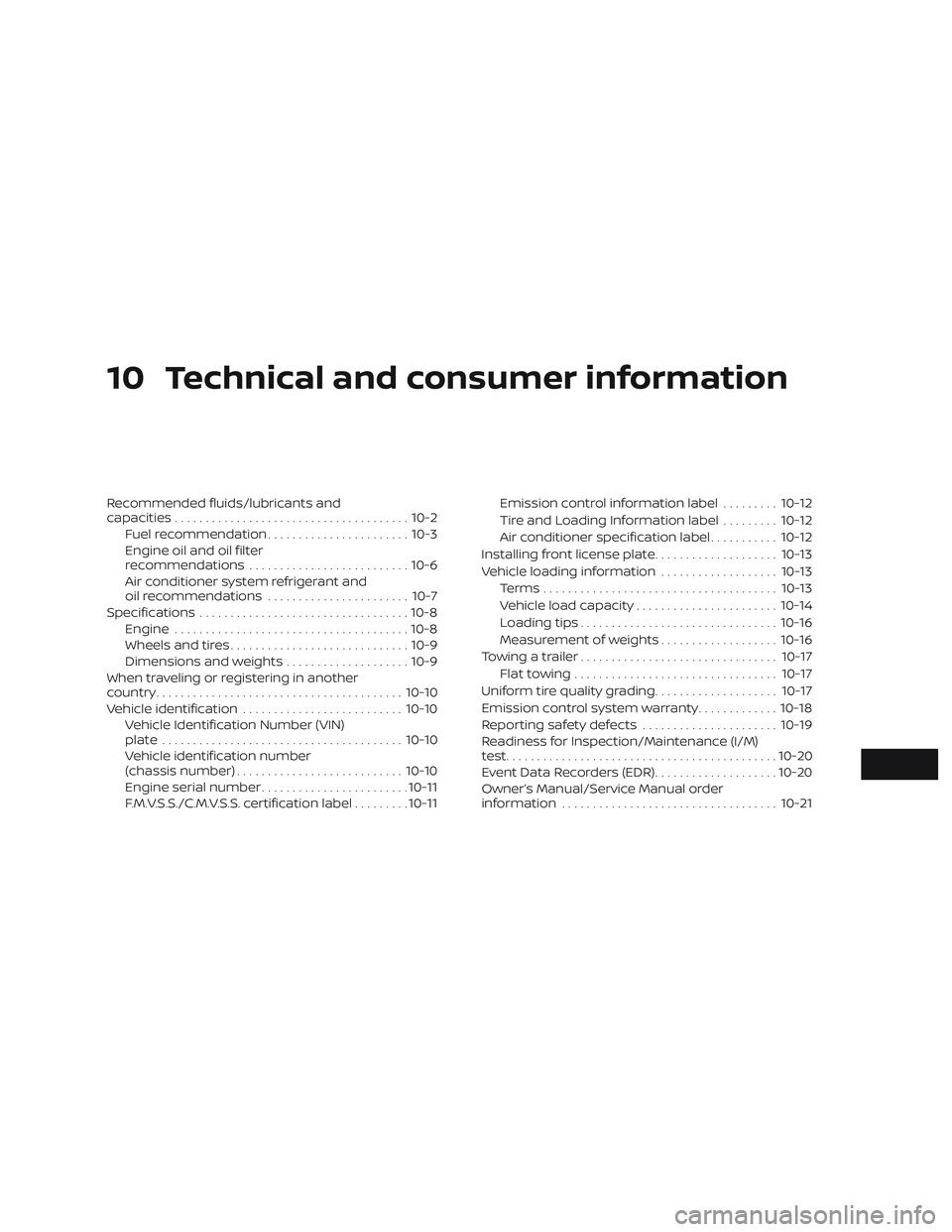
10 Technical and consumer information
Recommended fluids/lubricants and
capacities...................................... 10-2
Fuel recommendation ....................... 10-3
Engine oil and oil filter
recommendations .......................... 10-6
Air conditioner system refrigerant and
oil recommendations ....................... 10-7
Specifications .................................. 10-8
Engine ...................................... 10-8
Wheels and tires ............................. 10-9
Dimensions and weights ....................10-9
When traveling or registering in another
country ........................................ 10-10
Vehicle identification .......................... 10-10
Vehicle Identification Number (VIN)
plate ....................................... 10-10
Vehicle identification number
(chassis number) ........................... 10-10
Engine serial number ........................ 10-11
F.M.V.S.S./C.M.V.S.S. certification label .........10-11 Emission control information label
.........10-12
Tire and Loading Information label .........10-12
Air conditioner specification label ...........10-12
Installing front license plate ....................10-13
Vehicle loading information ...................10-13
Terms ...................................... 10-13
Vehicle load capacity ....................... 10-14
Loading tips ................................ 10-16
Measurement of weights ...................10-16
Towing a trailer ................................ 10-17
Flat towing ................................. 10-17
Uniform tire quality grading ....................10-17
Emission control system warranty .............10-18
Reporting safety defects ......................10-19
Readiness for Inspection/Maintenance (I/M)
test ............................................ 10-20
Event Data Recorders (EDR) ....................10-20
Owner’s Manual/Service Manual order
information ................................... 10-21
Page 434 of 467
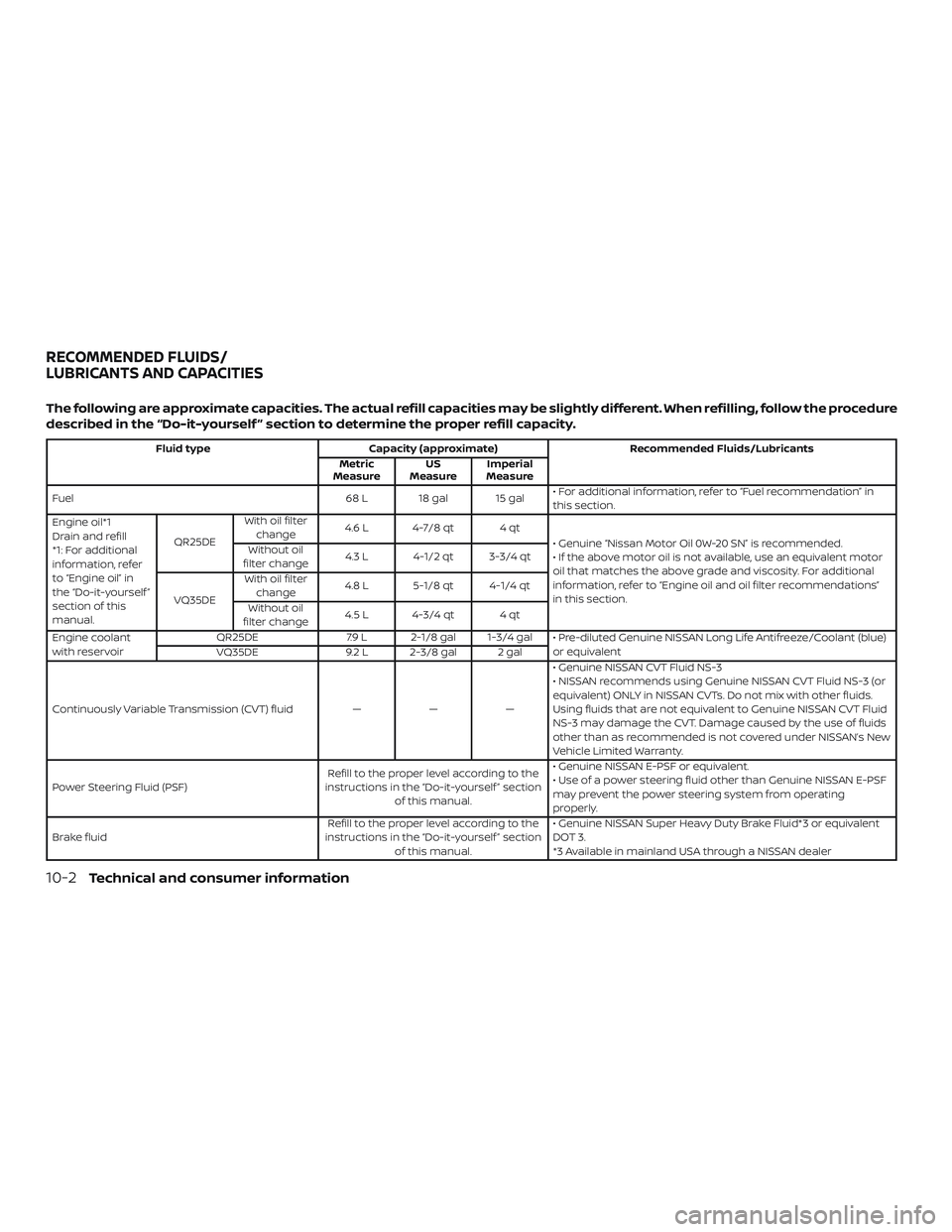
The following are approximate capacities. The actual refill capacities may be slightly different. When refilling, follow the procedure
described in the “Do-it-yourself ” section to determine the proper refill capacity.
Fluid typeCapacity (approximate) Recommended Fluids/Lubricants
Metric
Measure US
Measure Imperial
Measure
Fuel 68 L 18 gal 15 gal• For additional information, refer to “Fuel recommendation” in
this section.
Engine oil*1
Drain and refill
*1: For additional
information, refer
to “Engine oil” in
the “Do-it-yourself ”
section of this
manual. QR25DE
With oil filter
change 4.6 L 4-7/8 qt 4 qt
• Genuine “Nissan Motor Oil 0W-20 SN” is recommended.
• If the above motor oil is not available, use an equivalent motor
oil that matches the above grade and viscosity. For additional
information, refer to “Engine oil and oil filter recommendations”
in this section.
Without oil
filter change 4.3 L 4-1/2 qt 3-3/4 qt
VQ35DE With oil filter
change 4.8 L 5-1/8 qt 4-1/4 qt
Without oil
filter change 4.5 L 4-3/4 qt 4 qt
Engine coolant
with reservoir QR25DE
7.9 L 2-1/8 gal 1-3/4 gal
• Pre-diluted Genuine NISSAN Long Life Antifreeze/Coolant (blue)
or equivalent
VQ35DE 9.2 L 2-3/8 gal 2 gal
Continuously Variable Transmission (CVT) fluid ———• Genuine NISSAN CVT Fluid NS-3
• NISSAN recommends using Genuine NISSAN CVT Fluid NS-3 (or
equivalent) ONLY in NISSAN CVTs. Do not mix with other fluids.
Using fluids that are not equivalent to Genuine NISSAN CVT Fluid
NS-3 may damage the CVT. Damage caused by the use of fluids
other than as recommended is not covered under NISSAN’s New
Vehicle Limited Warranty.
Power Steering Fluid (PSF) Refill to the proper level according to the
instructions in the “Do-it-yourself ” section of this manual. • Genuine NISSAN E-PSF or equivalent.
• Use of a power steering fluid other than Genuine NISSAN E-PSF
may prevent the power steering system from operating
properly.
Brake fluid Refill to the proper level according to the
instructions in the “Do-it-yourself ” section of this manual. • Genuine NISSAN Super Heavy Duty Brake Fluid*3 or equivalent
DOT 3.
*3 Available in mainland USA through a NISSAN dealer
RECOMMENDED FLUIDS/
LUBRICANTS AND CAPACITIES
10-2Technical and consumer information
Page 438 of 467

ENGINE OIL AND OIL FILTER
RECOMMENDATIONS
Selecting the correct oil
It is essential to choose the correct grade,
quality and viscosity engine oil to ensure
satisfactory engine life and performance.
For additional information, refer to “Recom-
mended fluids/lubricants and capacities”
in this section. NISSAN recommends the
use of an energy conserving oil in order to
improve fuel economy.
Select only engine oils that meet the
American Petroleum Institute (API) certifi-cation or International Lubricant Standard-
ization and Approval Committee (ILSAC)
certification and SAE viscosity standard.
These oils have the API certification mark
on the front of the container. Oils which do
not have the specified quality label should
not be used as they could cause engine
damage.
Oil additives
NISSAN does not recommend the use of oil
additives. The use of an oil additive is not
necessary when the proper oil type is used
and maintenance intervals are followed.Oil which may contain foreign matter or
has been previously used should not be
used.
Oil viscosity
The engine oil viscosity or thickness
changes with temperature. Because of
this, it is important to select the engine oil
viscosity based on the temperatures at
which the vehicle will be operated before
the next oil change. Choosing an oil viscos-
ity other than that recommended could
cause serious engine damage.
Selecting the correct oil filter
Your new NISSAN vehicle is equipped with a
high-quality Genuine NISSAN oil filter. When
replacing, use a Genuine NISSAN oil filter or
its equivalent for the reason described in
“Change intervals.”
Change intervals
The oil and oil filter change intervals for
your engine are based on the use of the
specified quality oils and filters. Using en-
gine oil and filters that are not of the speci-
fied quality, or exceeding recommended oil
and filter change intervals could reduce
engine life. Damage to the engine caused
by improper maintenance or use of incor-
LTI2051
10-6Technical and consumer information
Page 455 of 467
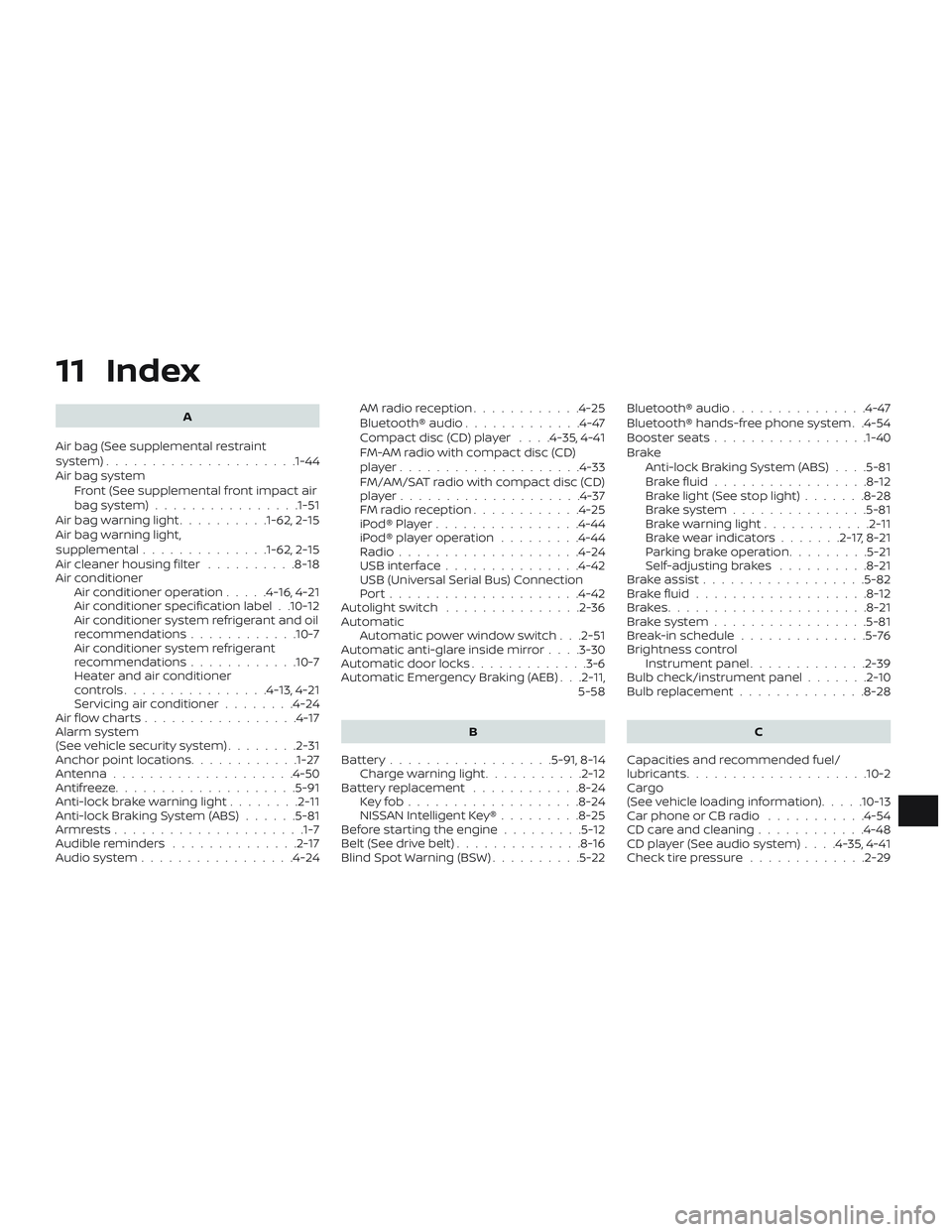
11 Index
A
Air bag (See supplemental restraint
system) .................... .1-44
Air bag system Front (See supplemental front impact air
bagsystem)................1-51
Airbagwarninglight..........1-62, 2-15
Air bag warning light,
supplemental ..............1-62, 2-15
Air cleaner housing filter ..........8-18
Air conditioner Air conditioner operation .....4-16,4-21
Air conditioner specification label . .10-12
Air conditioner system refrigerant and oil
recommendations ............10-7
Air conditioner system refrigerant
recommendations ............10-7
Heater and air conditioner
controls................4-13,4-21
Servicing air conditioner ........4-24
Air flow charts .................4-17
Alarm system
(See vehicle security system) ........2-31
Anchor point locations ............1-27
Antenna ....................4-50
Antifreeze ....................5-91
Anti-lock brake warning light ........2-11
Anti-lock Braking System (ABS) ......5-81
Armrests.................... .1-7
Audible reminders ..............2-17
Audio system .................4-24 AMradioreception............4-25
Bluetooth® audio
.............4-47
Compact disc (CD) player ....4-35,4-41
FM-AM radio with compact disc (CD)
player....................4-33
FM/AM/SAT radio with compact disc (CD)
player....................4-37
FMradioreception............4-25
iPod®Player................4-44
iPod® player operation .........4-44
Radio ....................4-24
USBinterface...............4-42
USB (Universal Serial Bus) Connection
Port.....................4-42
Autolightswitch ...............2-36
Automatic Automatic power window switch . . .2-51
Automatic anti-glare inside mirror ....3-30
Automatic door locks .............3-6
Automatic Emergency Braking (AEB) . . .2-11, 5-58
B
Battery..................5-91,8-14 Charge warning light ...........2-12
Battery replacement ............8-24
Keyfob...................8-24
NISSAN Intelligent Key® .........8-25
Before starting the engine .........5-12
Belt(Seedrivebelt)..............8-16
Blind Spot Warning (BSW) ..........5-22Bluetooth® audio
...............4-47
Bluetooth® hands-free phone system . .4-54
Booster seats .................1-40
Brake Anti-lock Braking System (ABS) . . . .5-81
Brakefluid.................8-12
Brakelight(Seestoplight).......8-28
Brakesystem...............5-81
Brakewarninglight............2-11
Brakewearindicators.......2-17,8-21
Parking brake operation .........5-21
Self-adjustingbrakes ..........8-21
Brakeassist..................5-82
Brakefluid...................8-12
Brakes......................8-21
Brakesystem.................5-81
Break-in schedule ..............5-76
Brightness control Instrument panel .............2-39
Bulb check/instrument panel .......2-10
Bulb replacement ..............8-28
C
Capacities and recommended fuel/
lubricants....................10-2
Cargo
(See
vehicle loading information) .....10-13
Car phone or CB radio ...........4-54
CDcareandcleaning........... .4-48
CD player (See audio system) ....4-35,4-41
Check tire pressure .............2-29
Page 456 of 467
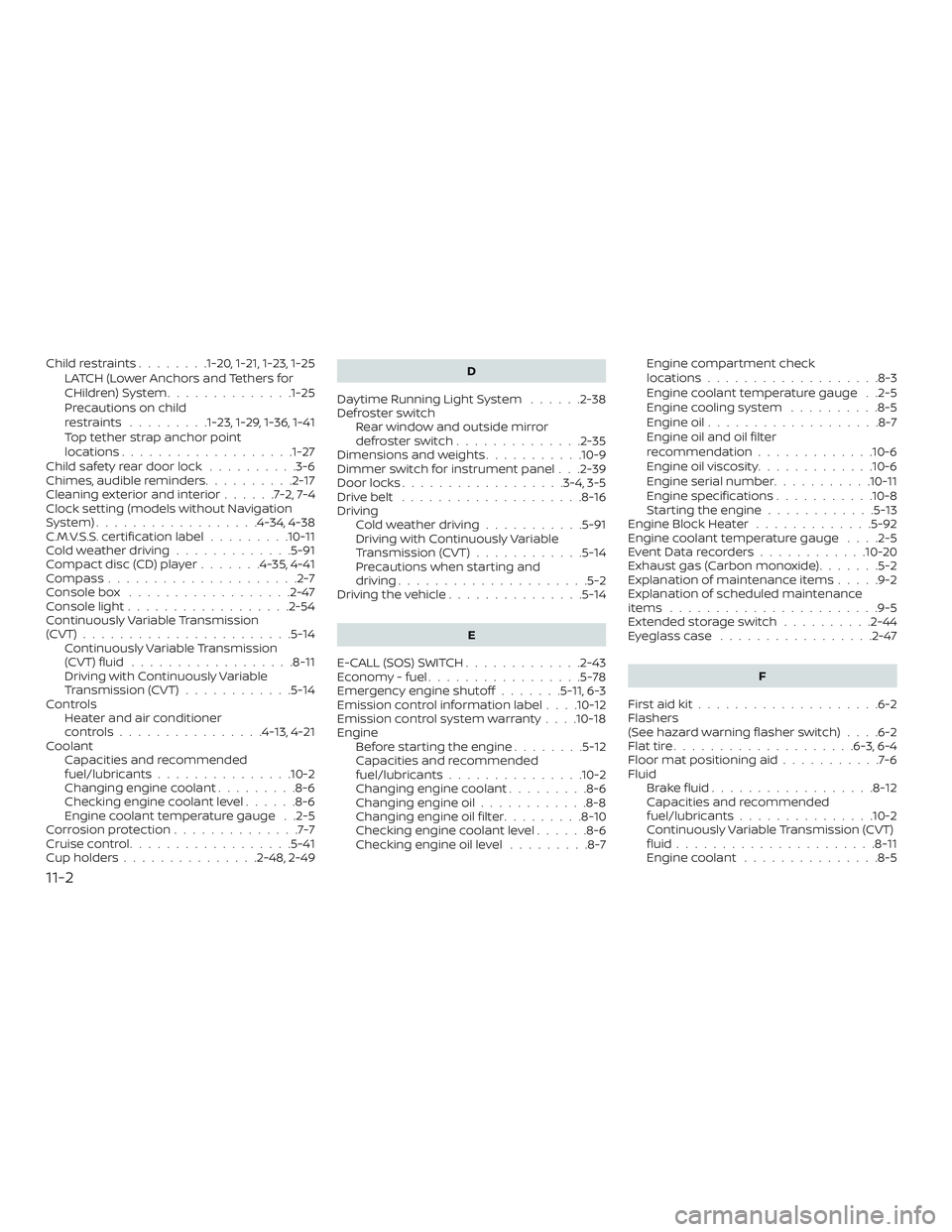
Childrestraints........1-20, 1-21, 1-23, 1-25LATCH (Lower Anchors and Tethers for
CHildren)System..............1-25
Precautions on child
restraints .........1-23, 1-29, 1-36, 1-41
Top tether strap anchor point
locations.................. .1-27
Child safety rear door lock ..........3-6
Chimes, audible reminders ..........2-17
Cleaningexteriorandinterior......7-2,7-4
Clock setting (models without Navigation
System)..................4-34,4-38
C.M.V.S.S. certification label .........10-11
Coldweatherdriving.............5-91
Compact disc (CD) player .......4-35,4-41
Compass .....................2-7
Console box ..................2-47
Console light ..................2-54
Continuously Variable Transmission
(CVT) .......................5-14
Continuously Variable Transmission
(CVT) fluid ..................8-11
Driving with Continuously Variable
Transmission (CVT) ............5-14
Controls Heater and air conditioner
controls................4-13,4-21
Coolant Capacities and recommended
fuel/lubricants...............10-2
Changing engine coolant .........8-6
Checking engine coolant level ......8-6
Engine coolant temperature gauge . .2-5
Corrosionprotection..............7-7
Cruisecontrol..................5-41
Cupholders...............2-48,2-49 D
Daytime Running Light System ......2-38
Defroster switch Rear window and outside mirror
defrosterswitch..............2-35
Dimensions and weights ...........10-9
Dimmer switch for instrument panel . . .2-39
Door locks ..................3-4,3-5
Drivebelt ....................8-16
Driving Cold weather driving ...........5-91
Driving with Continuously Variable
Transmission (CVT) ............5-14
Precautions when starting and
driving.....................5-2
Drivingthevehicle...............5-14
E
E-CALL (SOS) SWITCH .............2-43
Economy - fuel .................5-78
Emergency engine shutoff .......5-11, 6-3
Emission control information label . . . .10-12
Emission control system warranty . . . .10-18
Engine Before starting the engine ........5-12
Capacities and recommended
fuel/lubricants...............10-2
Changing engine coolant .........8-6
Changing engine oil ............8-8
Changing engine oil filter .........8-10
Checking engine coolant level ......8-6
Checking engine oil level .........8-7Engine compartment check
locations...................8-3
Engine coolant temperature gauge . .2-5
Engine cooling system
..........8-5
Engine oil ...................8-7
Engine oil and oil filter
recommendation .............10-6
Engine oil viscosity .............10-6
Engine serial number ...........10-11
Engine specifications ...........10-8
Starting the engine ............5-13
Engine Block Heater .............5-92
Engine coolant temperature gauge ....2-5
EventDatarecorders............10-20
Exhaust gas (Carbon monoxide) .......5-2
Explanation of maintenance items .....9-2
Explanation of scheduled maintenance
i
tems .......................9-5
Extended storage switch ..........2-44
Eyeglasscase .................2-47
F
Firstaidkit....................6-2
Flashers
(Seehazardwarningflasherswitch)....6-2
Flattire....................6-3,6-4
Floormatpositioningaid...........7-6
Fluid Brakefluid..................8-12
Capacities and recommended
fuel/lubricants...............10-2
Continuously Variable Transmission (CVT)
fluid......................8-11
Engine coolant ...............8-5
11-2
Page 457 of 467
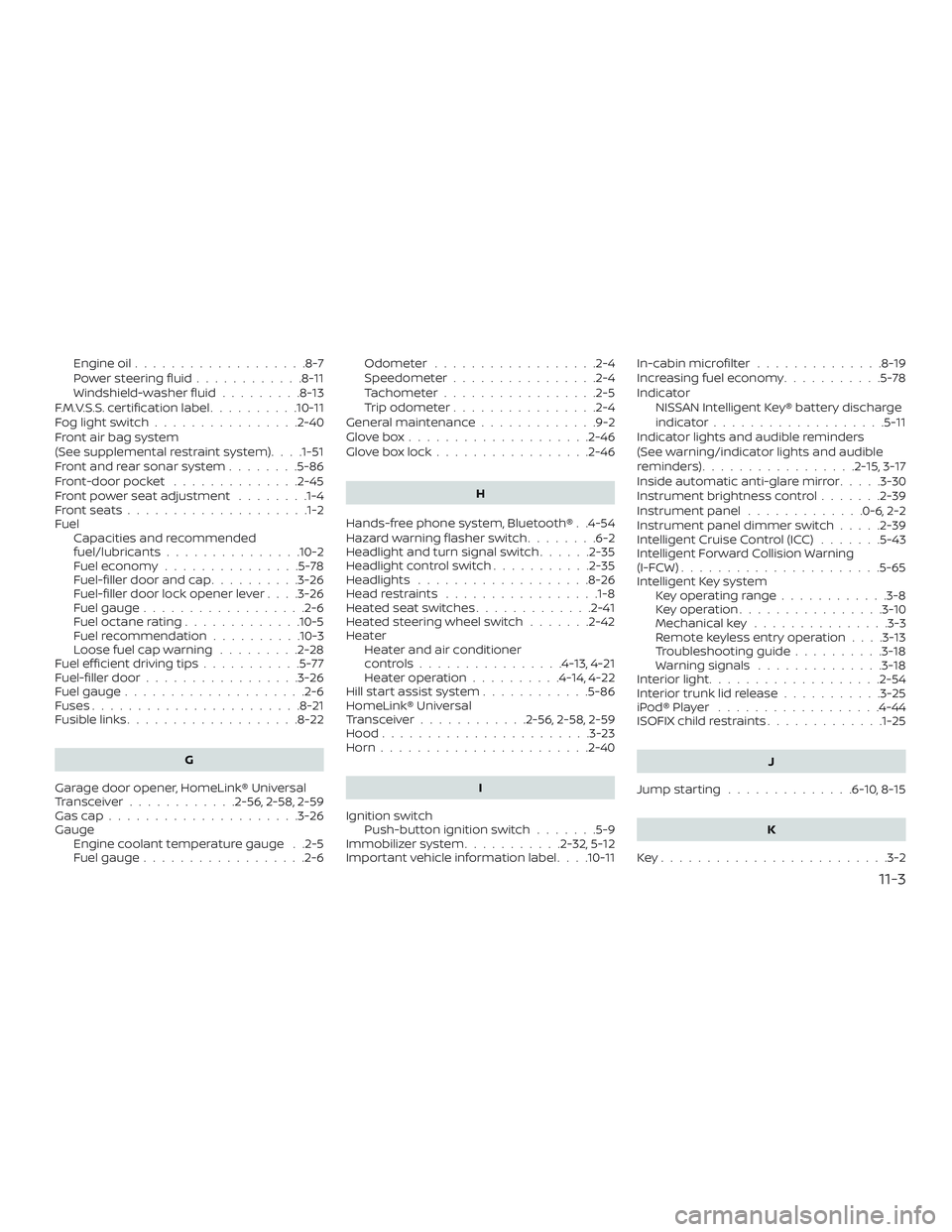
Engine oil...................8-7
Powersteeringfluid............8-11
Windshield-washer fluid .........8-13
F.M.V.S.S. certification label ..........10-11
Foglightswitch................2-40
Front air bag system
(See supplemental restraint system) . . . .1-51
Front and rear sonar system ........5-86
Front-door pocket ..............2-45
Front power seat adjustment ........1-4
Frontseats................... .1-2
Fuel Capacities and recommended
fuel/lubricants...............10-2
Fuel economy ...............5-78
Fuel-filler door and cap ..........3-26
Fuel-filler door lock opener lever ....3-26
Fuel gauge ..................2-6
Fueloctanerating.............10-5
Fuel recommendation ..........10-3
Loose fuel cap warning .........2-28
Fuelefficientdrivingtips...........5-77
Fuel-filler door .................3-26
Fuel gauge ....................2-6
Fuses .......................8-21
Fusiblelinks...................8-22
G
Garage door opener, HomeLink® Universal
Transceiver ............2-56,2-58,2-59
Gascap.....................3-26
Gauge Engine coolant temperature gauge . .2-5
Fuel gauge ..................2-6 Odometer
..................2-4
Speedometer ................2-4
Tachometer .................2-5
Trip odometer ................2-4
General maintenance .............9-2
Glovebox....................2-46
Gloveboxlock.................2-46
H
Hands-free phone system, Bluetooth® . .4-54
Hazard warning flasher switch ........6-2
Headlight and turn signal switch ......2-35
Headlightcontrolswitch...........2-35
Headlights ...................8-26
Headrestraints .................1-8
Heated seat switches .............2-41
Heated steering wheel switch .......2-42
Heater Heater and air conditioner
controls................4-13,4-21
Heater operation ..........4-14,4-22
Hill start assist system ............5-86
HomeLink® Universal
Transceiver ............2-56,2-58,2-59
Hood .......................3-23
Horn.......................2-40
I
Ignition switch Push-button ignition switch .......5-9
Immobilizer system ...........2-32,5-12
Important vehicle information label . . . .10-11In-cabinmicrofilter ..............8-19
Increasing fuel economy
...........5-78
Indicator NISSAN Intelligent Key® battery discharge
indicator...................5-11
Indicator lights and audible reminders
(See warning/indicator lights and audible
reminders) .................2-15,3-17
Inside automatic anti-glare mirror .....3-30
Instrument brightness control .......2-39
Instrument panel .............0-6,2-2
Instrument panel dimmer switch .....2-39
Intelligent
Cruise Control (ICC) .......5-43
Intelligent Forward Collision Warning
(I-FCW)......................5-65
Intelligent Key system Key operating range ............3-8
Key operation ................3-10
Mechanical key ...............3-3
Remote keyless entry operation ....3-13
Troubleshooting guide ..........3-18
Warning signals ..............3-18
Interiorlight...................2-54
Interiortrunklidrelease...........3-25
iPod®Player ..................4-44
ISOFIX child restraints .............1-25
J
Jumpstarting..............6-10,8-15
K
Key........................ .3-2
11-3